Man to Man Defense – Basics
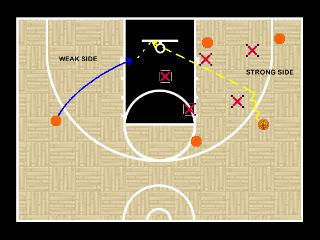
Youth Basketball Man to Man Defenses are very hard to learn and execute for younger players. Defense is attitude, hustle, and aggressiveness all packed into one. Coaches must motivate players to play good defense! Players practice shooting, dribbling, free throws, etc, but you never see a player practicing defense on their own. Players must be able to play at both ends of the court. Coaches should practice defense just as much, or more than offense. Players must understand how playing good “team” and help defense is extremely important to the success of the team.
Coaches – Please understand that there is more to Man to Man defense than what can be explained on this page. The info on this page is just a small part of the Man to Man defensive scheme taken from our new AVCSS Basketball download publication “Man to Man Defenses for Youth Basketball” .
Understand how a Man to Man defense can easily be beaten!
The fastest way would be for your opponents offense to “beat” your defense up the floor – which means the other team will try to run their fast break (transition offense) up the floor quickly before you have a chance to set up your man to man defense. Coaches must teach their players to get back on defense quickly – set up the man to man defense, and be prepared to help!
General Pointers – Man to Man Defense
The Basic Defensive Stance
Not all of the players on your team will be good ball handlers or shooters, but there is no reason that a player cannot play good defense. Teach your players the basic fundamentals of a defensive stance. Good team defense cannot succeed if the players don’t use the correct defensive stance. Defensive Stance – Players feet should be shoulder width apart, Keep knees bent (be in a “sitting” position), Players head should be up, back should be straight, Players weight should be evenly distributed on the “balls of their feet,” never lean back on the heels, Hands should be up and out with palms facing up, Players should always stay low and level (younger players tend to “bounce up and down” when doing defensive drills).
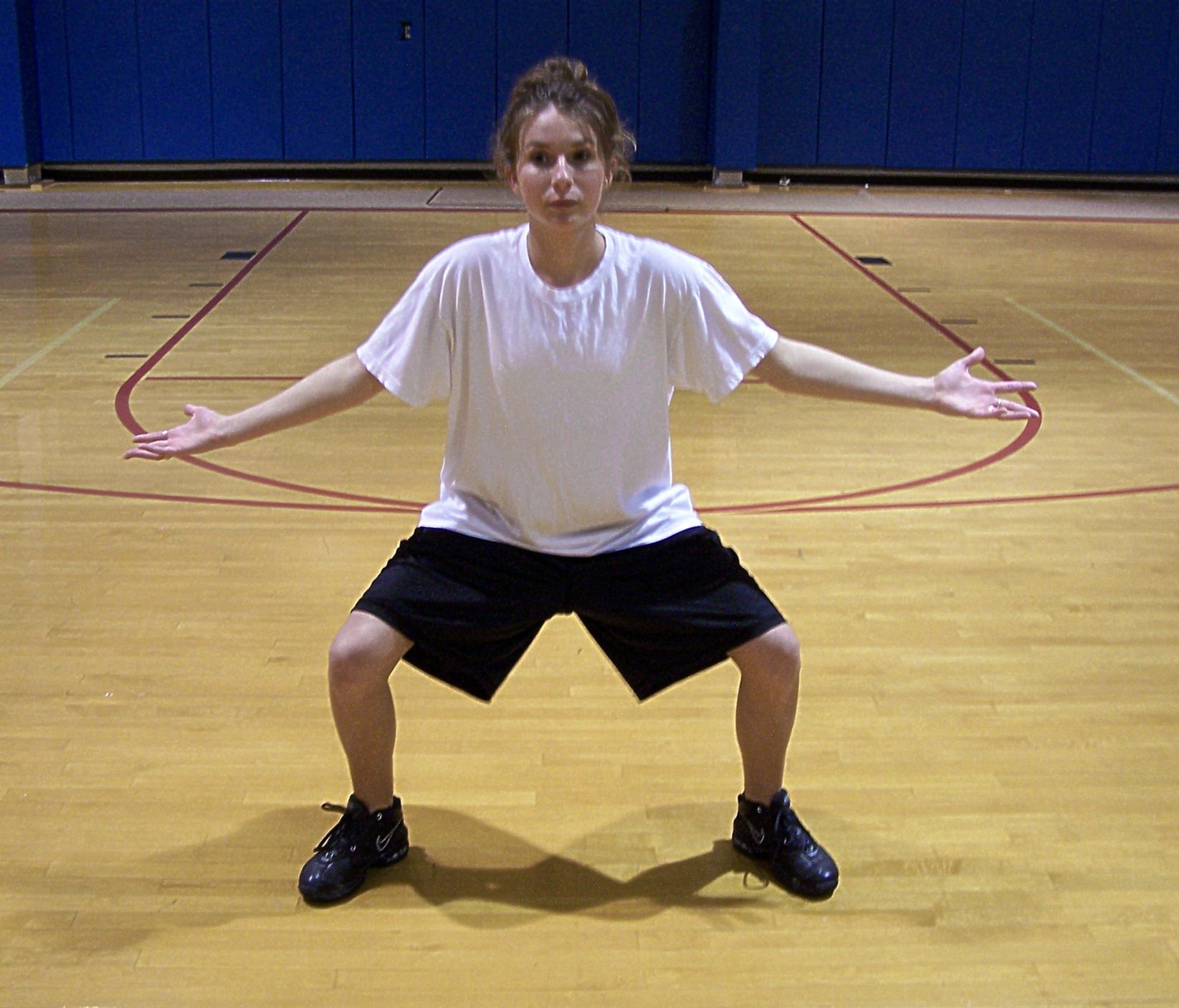
The “Quarter Turn” Stance
It is important to understand the different stances used in basketball. Here is the quarter-turn stance (all players should know and use this stance in both man to man, and zone defenses). Quarter-Turn Stance – The defender (in blue) is standing to the side of the offensive player (one hand in front, and one hand behind). Use this stance to avoid getting “sealed” off by the offensive player.
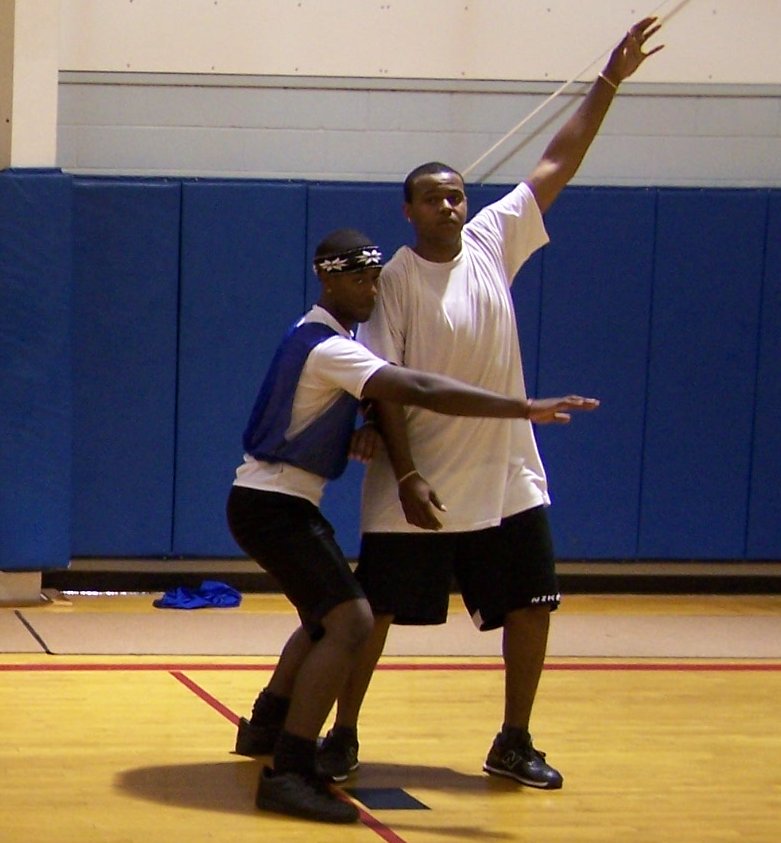
The Quarter-Turn Stance
The “Fronting” and “Behind” Stance
1. X1 Is “Fronting” a player in the low post area to keep the offensive player from getting an entry pass (deny the player the ball). Deny the ball to offensive players that have excellent low post moves.
2. X2 is “Behind” the player in the high post area and will allow the offensive player the entry pass up high only. Allow a post player that does not have a strong outside jump shot up high to get the ball in the high post area where they cannot hurt you offensively.
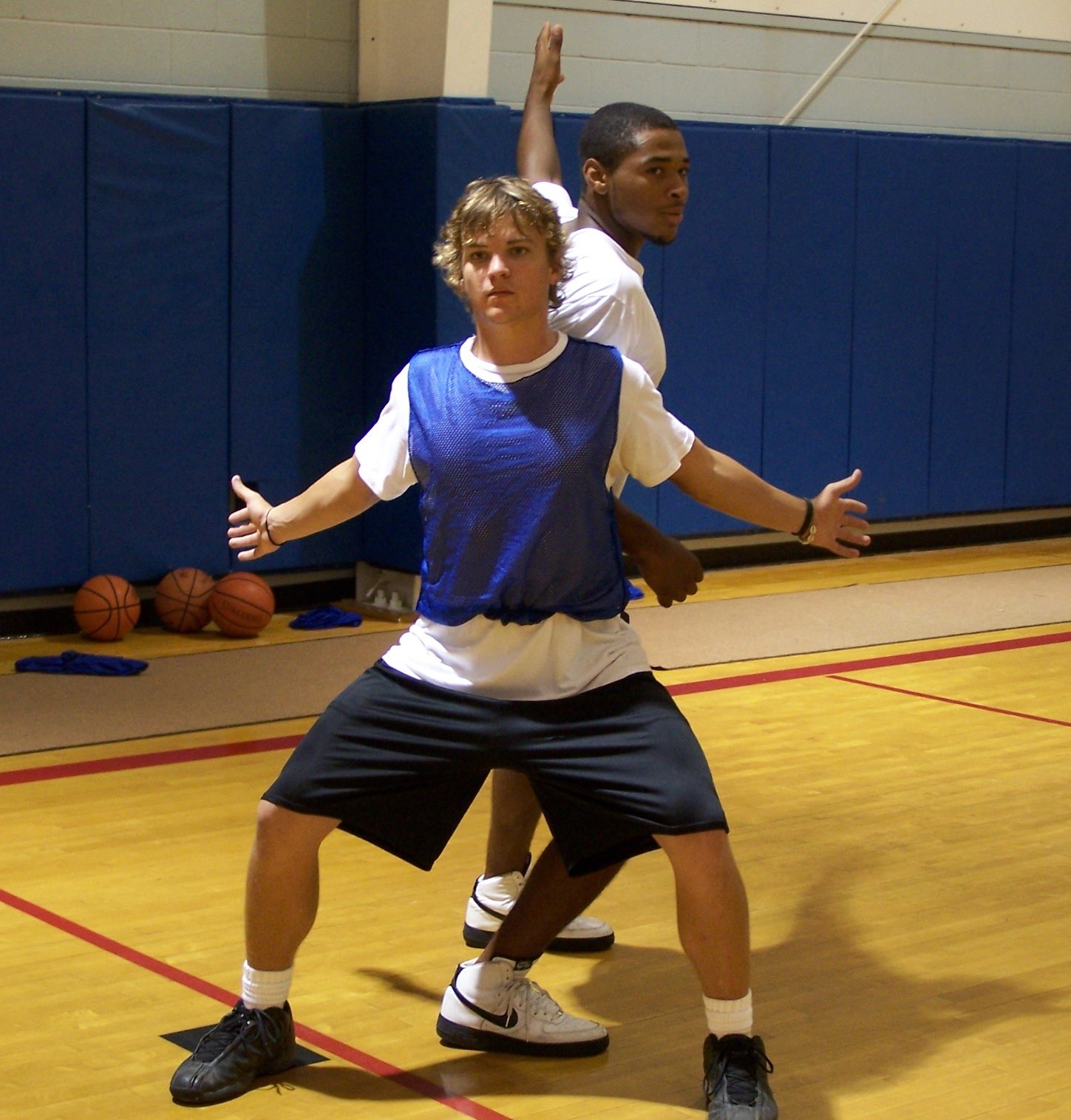 Player in Blue is “Fronting” the post player.
Player in Blue is “Fronting” the post player. 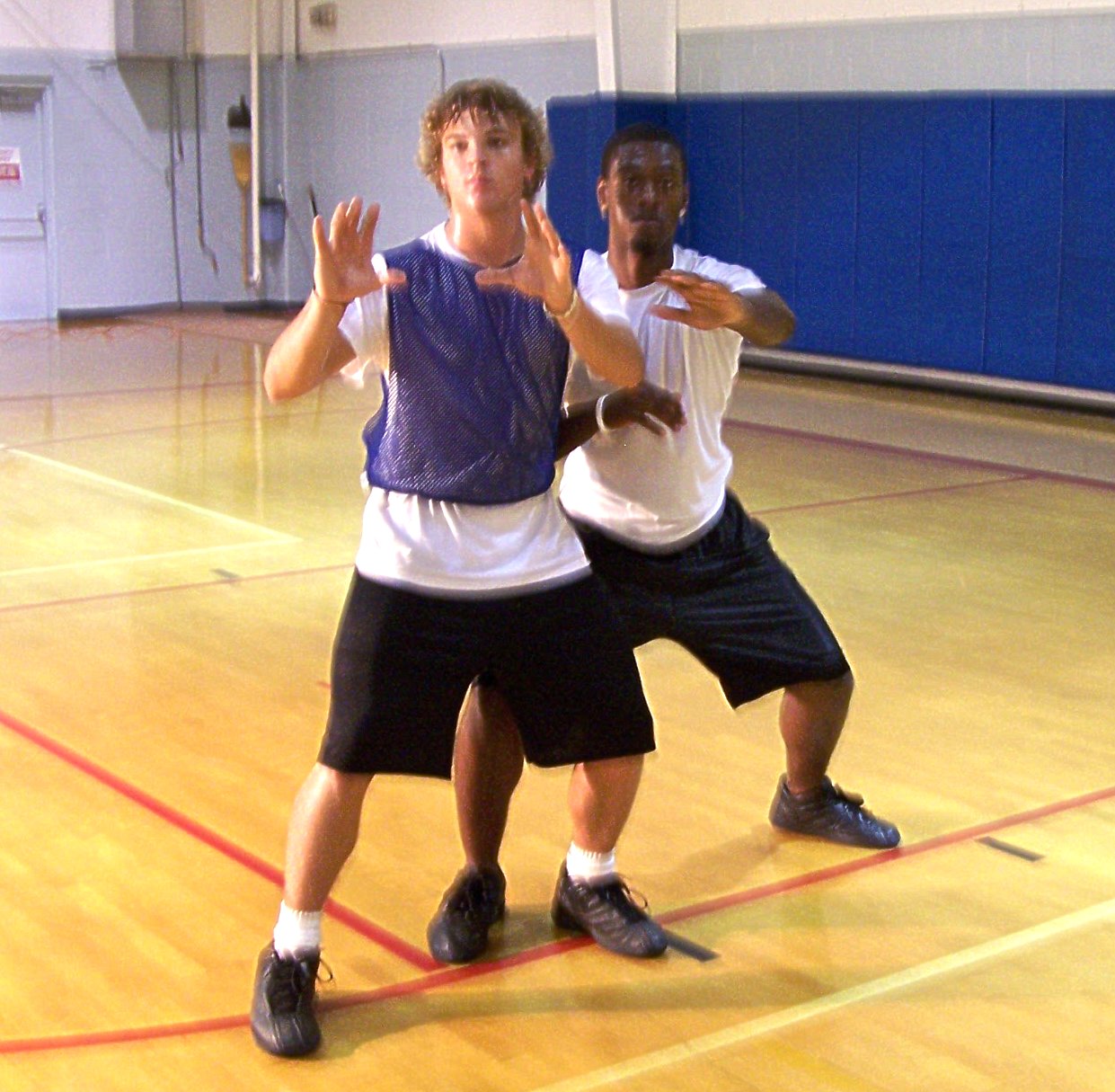 Player in White defending “Behind” the player in Blue.
Player in White defending “Behind” the player in Blue.
If you need more information on the basics of defense try our menu page – The Basic Principles of Defense
The “Basic Principles of Defense” Menu Page
Basic Man to Man Defense – Teaching Points / Notes:
The Gap:
“How far defenders should stay away from the player with the ball.” It is very important for defenders to “know” the strengths of the player they are guarding. Although the sayings “stick to your player like glue” and “cover the player like a wet Blanket” are common place, it is sometimes not very good advice in certain Man-to-Man situations. It is important for defenders to understand the players strengths they are guarding. If the player they are guarding is not a good “driver” but rather a good “shooter” – they should guard the shooter closely! If the player they are guarding is a poor shooter, but a very good “driver” – they should keep a “gap” between them far enough away to to keep from getting “beat” (off the dribble) to the basket – a defender must be in a position to “recover” if the player drives to the basket.
Steering
(take away your opponents strengths):
“Steering” an offensive player means to “force” a player to use their weaker hand to dribble! Players will tend to want to dribble with their right hand only (strong hand could be the right or left) defenders should force these players to dribble with their left (or right – depending on which is their strong dribbling hand). This puts the dribbler in an uncomfortable position (causing turnovers, they pick up their dribble, etc).
Steering the Ball Handler Example
Talking it up on Defense:
It is very important for defenders to “talk” to each other while the game is going on. Examples of “talking it up” are: “Help” (used when a defender gets “beat”), “Cutter” (used when offensive players are cutting across a defenders area), “Switch” (used when a player is getting screened and cannot guard their player), “Shot” (used by the defense to “alert” other defenders that an offensive player has shot the ball).
Boxing Out is Every Players Responsibility:
Man-to-Man Defense demands that every defensive player on the court boxes out the player that they are guarding. It is also very important that players yell out “shot” when the player they are guarding takes the shot! This “alerts the other defenders to “box out.” Boxing out is the responsibility of every player, not just the post players (forwards and centers). How many times has a guard taken a “shot” and hustled to get their own rebound, and scored? This happens because most of the “guards” do not bother to box out the player they are guarding – Boxing out is every players responsibility!
Boxing Out Example / Right Side
Switching / Help Defense
All Switching (helping) occurs during “screens.” This occurs when an offensive player sets a screen on a defender, and the defenders can see what’s about to occur. Defenders need to react quickly enough to communicate the “switch” to each other. The defender that is guarding a player that is getting ready to screen another defender yells out “switch.” The defender that gets screened yells out “help” and the defenders automatically switch players to guard. Switching / helping is somewhat “controversial” part of Man-to-Man defense. Some coaches prefer and teach their players “not to switch” at all. Some coaches prefer that their players switch “all the time,” and some coaches prefer that their players only switch near the basket / baseline. The “preference” taught in the
Switching / Help Above the Elbow
Switching / Help Below the Elbow
AVCSS Basketball publication is: Above the elbow have the players “fight” through all screens, and below the elbow (priority being the baseline screens) have the players “switch.”
Taking the Charge!
One of the most underrated skills of a defensive player is “taking the charge.” A “charge” is when an offensive player runs into (or runs over) a defensive player that has established position on defense. The term “taking the charge” is meant for the defender – when they get in a position to take the charge. It is a hard skill to master, it takes a lot of mental toughness for a young player to put themselves in a position to get “run over” by an offensive player running full speed at them.
Teach your players the basics of “Taking a Charge” – Handout
Basic Teaching Points
Notes of the Man to Man Defensive Scheme:
Ball Side / Help Side:
The first step in learning good Man to Man defense is to understand Ball Side / Help Side.
2 on 2 Ball Side / Help Side Drill
Ball Side
The side that the ball is on, and usually the side that the majority of players are on. The diagram to the right shows that X3, X5, X4, and X1 are all defenders on the “Ball Side” of the court. Note: Usually called “Strong Side” when referring to zone defenses.
Help Side
The side away from the ball, and usually the side that has the least amount of players. The diagram shows that only X2 is the only defender on the “Help Side” of the court. Note: Usually called “Weak Side” when referring to zone defenses. Very important help defense note.
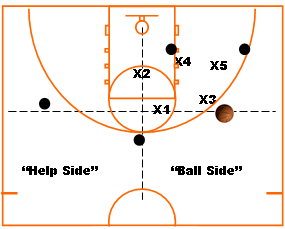
On the Line / Up the Line: (See Handout Below)
The second step in learning good Man to Man defense is to understand the On the Line / Up the Line positions.
Imaginary Passing Lanes (Lines)
A key element of “On the Line – Up the Line” is the concept of the “Imaginary Passing Lanes.” Simply, these are lines for any path that a pass can travel between two offensive players. Players need to “see” these imaginary lines between the offensive players to understand and play proper “Man-to-Man” defense.

Imaginary Passing Lanes (Lines)
“On the Line”
Refers to which part of a defenders body will be on the passing lane. Coaches use different approaches: Some coaches teach players to put their left or right hand on the passing lane, Some teach players to put their head on the passing lane, and some teach players to put the body on the passing lane. We are using “hands” on the passing lane!
“Up the Line”
Up the line refers to how far a defenders body will be on the passing line. How far up the line is usually up to the coach. The approach used in this book is for the defender to be about 3-4 feet up the line from the player that they are guarding. Coaches should adjust the distance a defender should play up the line vs. the skills of the defender (speed, quickness, etc).
On the Line / Up the Line Man to Man Drill
On the Line / Up the Line Man to Man Drill (Post Players)
Handout – On the Line / Up the Line
Note: On the Line / Up the Line is also referred to as “One Pass Away” defense! This is because when a player is in the “Help” mode, they should be in a position. The position of “One Pass Away” from the player they are guarding.
Putting it all together – The “Shell Drill”
The “Shell Drill” is one of the best drills to practice the principles of Man to Man defense. The “Shell Drill” is commonly practiced with 4 players on defense, and 4 players on offense. Once your players get comfortable with the drill, add the 5th players. The main teaching point about the Shell Drill is to make sure that your players understand the basic principles first. Start slowly, one pass at a time and make sure the players are going where they are supposed to go. Then, pick it up a little at medium speed, and finally run the drill at “game speed” (which is the goal of the drill).
Shell Drill / Man to Man Drill
Hopefully the handout will help you understand the On the Line / Up the Line concept better. Additional info is covered in our publication…
WANT MORE INFO?
Check out the new AVCSS Basketball download publication “Man to Man Defenses for Youth Basketball”
Lots of information on Man to Man Defenses, with Diagrams and Video Clips. That help bring the information to life (can’t beat the price for this much information).
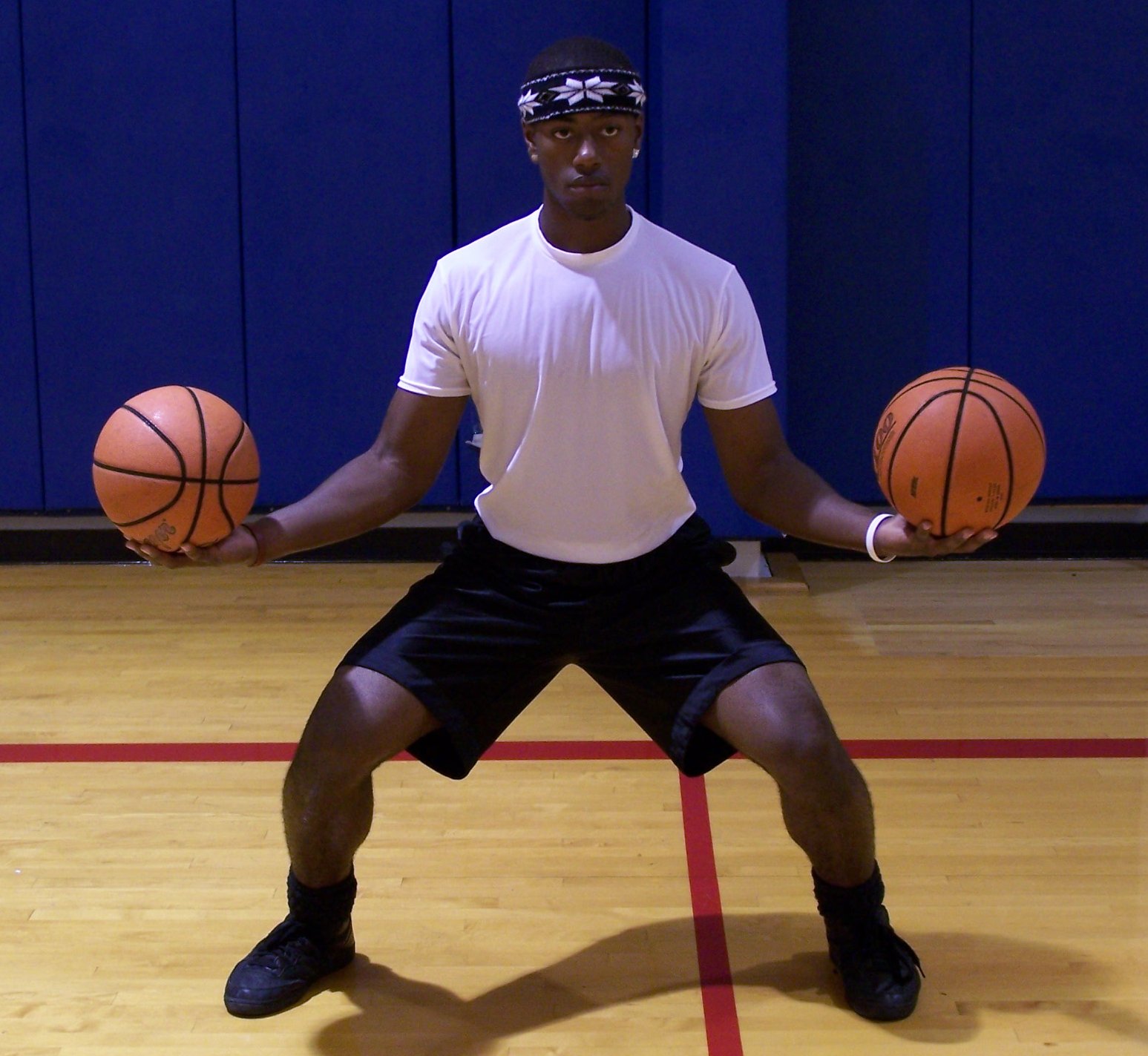
Man to Man Defense
Check out the Article on “1 on 1 Competitions” Here!



interesting as well as well explained
very truth full facts